Learn how to make gravy from scratch with this easy instructions. Using flour or other thickener, with or without pan dripping, you can have perfect gravy in about 10 minutes.
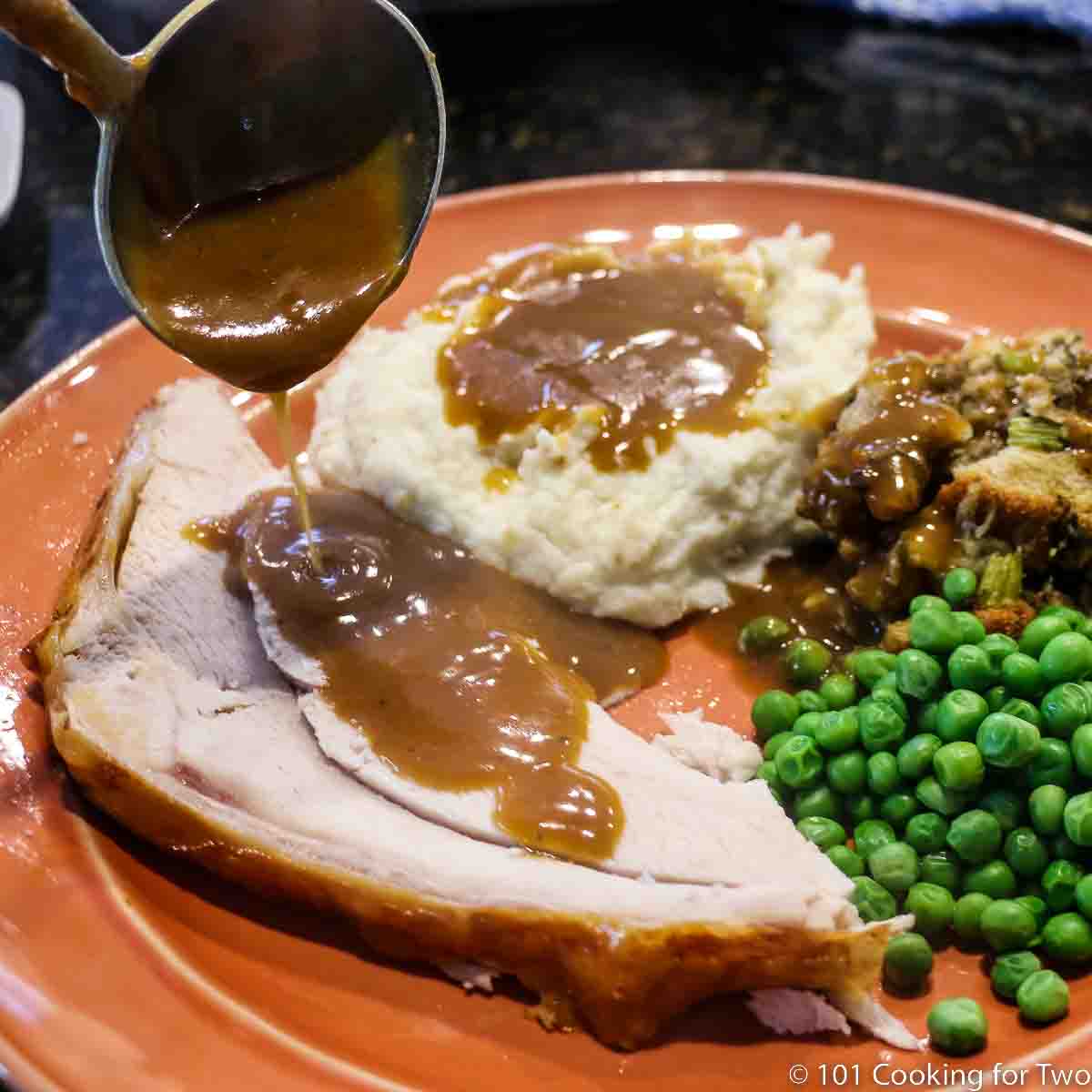

TABLE OF CONTENTS
- 👨🍳How to make gravy with a Slurry
- 👨🍳How to make gravy with a Roux
- Overview: Roux vs. Slurry Methods
- About Brown Gravy
- ❓Troubleshooting Gravy
- 🥣Gluten-Free Gravy and Alternate Thickeners
- Top Recipes with Gravy Recipes
- 👨🍳The Slurry Method Step-by-Step Photo Instructions
- 👨🍳The Roux Method Step-by-Step Photo Instructions
- 📖 Recipe
You can use either a roux or flour slurry to thick almost any liquid to make gravy, sauces or many other uses. This is a simple skill even beginner home cooks can and should master. With only 10 minutes and some pan drippings or broth, you will kick your meal up a few notches.
If your meat has pan drippings, it holds a considerable amount of taste you want to capture for your meal. And if there is fond on the pan, it is a treasure not to be missed. Both will enhance your homemade gravy.
Gravy will make you look like the kitchen master. Just follow these easy step-by-step instructions.
👨🍳How to make gravy with a Slurry
- Key ratio: for 1 cup of gravy, you will need 1 cup of broth/drippings and 2 tablespoons of flour. No fat is required. The broth can also be stock or water with bullion or gravy base.
- Combine about equal amounts of all-purpose flour and cool water or broth and mix until smooth. Make a bit extra to add more thickening if needed.
- If the pan drippings contain a large amount of fat (max. 2 tablespoons of fat per cup of gravy you are making), you need to remove most of the fat (a fat separator or skimming) or use fewer drippings. You can eliminate all the fat if you wish.
- Combine the remainder of your liquid with any remaining pan drippings and bring to a boil over medium-high heat—use two burners if a large pan.
- Slowly start pouring the flour mixture to the area of hardest boil SLOWLY while VIGOROUSLY stirring with a slotted spoon or whisk. Turn the heat down to simmer.
- Pay attention to the thickness, and stop adding the flour mixture when you get almost the consistency you want. It will thicken a little with the cooking in the next step
- Continue to cook for another 2-3 minutes while stirring continuously. Add a bit more flour mixture, if needed, to thicken more or dilute with some broth or water if too thick. Remove from heat and serve immediately.
👨🍳How to make gravy with a Roux
- Key ratio: for 1 cup of gravy, you will need 1 cup of broth, 2 tablespoons of fat, and 2 tablespoons of flour. The broth can also be stock or water with bullion or gravy base.
- Over medium-high heat, heat your fat (butter, drippings from meat, etc.)
- When the fat is hot, decrease the heat to medium and sprinkle in an equal amount of flour slowly while stirring or whisking continuously. Cook until the roux browning some—usually 3-5 minutes.
- Slowly pour in the liquid for the gravy. Add most of the liquid but not all.
- Stir continuously to combine and decrease the heat to simmer—cook for a few minutes. Add more liquid if needed. Simmer for a few minutes to cook the flour a bit more.
Overview: Roux vs. Slurry Methods
| Slurry Method | Roux Method | |
|---|---|---|
| Brief Description | Make a slurry of flour and liquid, then add to boiling liquid. | Making a paste of fat and flour. Cook for a few minutes, and then add liquid |
| Ingredients | Flour and liquid | Fat, flour, and liquid |
| Ratio for 1 cup | 2 tablespoons flour and 1 cup flour | 2 tablespoons fat, 2 tablespoons flour, 1 cup liquid |
| Fat required | No | Yes |
| Skill level | 2/10 | 4/10 |
| Ease of Thinning | Yes | Yes |
| Ease of adding thickening | Yes | Yes, but by adding thickening with a slurry |
| Advantage | Flexible, quick and easy to learn and use | It may have less "raw" flour taste and is the traditional method. |
| Disadvantage | Some feel there is a "raw" flour taste. | Fussier for beginners. |
Each method has advantages and disadvantages. I suggest beginners start with the slurry method.
This flexibility of the slurry method makes it easier for home cooks. Leave the drippings in the pan. Add some broth if you need to, and thicken. No need to make a roux.
The Slurry Method
The slurry method uses flour mixed with cool liquid in a bowl or shaker separate from the pan with dripping and the liquid to be thickened.
With this method, the flour starch is hydrated enough to prevent lumps before slowly being stirred into the drippings and liquid. It is then brought to a boil to help the liquid absorb and cook the "raw" out of the flour.
You can add more thickener if needed or dilute the gravy with some broth or water if needed.
The Roux Method
Making a roux is the classic method of thickening sauces and gravy.
The roux method starts with fat heated in a pan. Flour is added, then mixed into the fat until smooth—this is the roux. It is cooked until browning some to cook out the raw flour taste, usually only a few minutes. The browner the roux, the browner the gravy, and the less thickening power as the starch breaks down with a Maillard reaction.
About Brown Gravy
Brown gravy is gravy made from a meat stock or drippings—beef, pork, chicken, and other meats along with flour with either the slurry or roux methods. You can also use water with bullion or gravy base as the liquid.
Other things like onions, mushrooms, and other vegetables, along with spices and herbs and be added to suit your taste. Brown gravy can also be made vegetarian.
Some believe all brown gravy is beef based, which is not true. All beef-based gravy is brown gravy, but not all brown gravy is beef. Lastly, the darker the meat, the darker the gravy will become.
❓Troubleshooting Gravy
The lumps are usually flour that comes together into clumps, early in the process. With the slurry method, using hot liquid to dissolve the flour is the most common reason. But it can also occur if you add the flour mixture to the liquid for the gravy when it is not boiling.
In the roux method, you didn't whisk continuously while making the roux, didn't make sure the roux was smooth, or didn't mix well enough after adding the liquid.
You can run your gravy through a strainer and do better next time.
You can always add more taste with a soup base or bullion product which I always keep around. I can never find pork or turkey broth, so I make it with these products.
Other things like Worcestershire sauce or soy sauce can boost flavors, and don't forget your favorite herbs and spices like thyme, sage, or rosemary.
White gravy is gravy made with milk as the primary liquid. A typical example is the white gravy of chicken fried steak. I will usually use the leftover spiced-up flour coating mixture for the flour and the pan drippings, so there are a lot of flavors. This could be called a brown gravy, also.
Sausage gravy is a version of white gravy that uses milk and usually flour with cooked breakfast sausage. I use a slurry method and add seasoning salt and pepper. Again, this could be called a brown gravy.
Yes, gravy made with flour will refrigerate well for 4 to 5 days and freeze well for 3-4 months. The flour will absorb more fluid over time, so you may need to thin it a bit with broth or water when you reheat.
Gravy made with other thickeners will vary. Please see the discussion about alternate thickeners below.
🥣Gluten-Free Gravy and Alternate Thickeners
I'm only discussing a few common wheat flour alternative thickeners. I can not discuss every possible thickener, so I'm sticking to the ones I have used. I want to add that many alternative flours, like almond flours, are known as not good thickeners since thickening depends on starch.
Cornstarch
The most common alternative thickener is corn starch. Cornstarch has about double the thickening power of flour—so use half as much. Cornstarch-thickened liquids will have a clearer shiny appearance, and it holds up well to long cooking, but it can have a slight taste.
To thicken with cornstarch, make a slurry of cornstarch with a small amount of cold water. Get it completely smooth, and slowly add it to your hot liquid while mixing.
The major drawback of cornstarch is it tends to turn jello-like with refrigeration which is fine for strawberry pie but not gravy leftovers.
Arrowroot
Arrowroot is an excellent thickener. It is harder to find, but I keep a bottle in my pantry. Use 2 ½ teaspoons per cup of liquid to thicken so not quite as strong as flour.
Arrowroot has no taste and does freeze well. But it does not hold up well to more prolonged cooking. It also interacts with dairy products which limit its use.
Top Recipes with Gravy Recipes
How to Roast Turkey Breast the Easy Way
Healthier Sausage Gravy and Biscuits

👨🍳The Slurry Method Step-by-Step Photo Instructions
Key ratio: for 1 cup of gravy, you will need 1 cup of broth/drippings and 2 tablespoons of flour. The broth can also be stock or water with bullion or gravy base.
Equipment: Tupperware Quick Shaker is recommended, but a bowl and whisk will do. A stovetop pan with a large bottom, a large slotted spoon, or a whisk.
Please read and understand the instructions BEFORE you start. You will not have time to read and do this simultaneously.
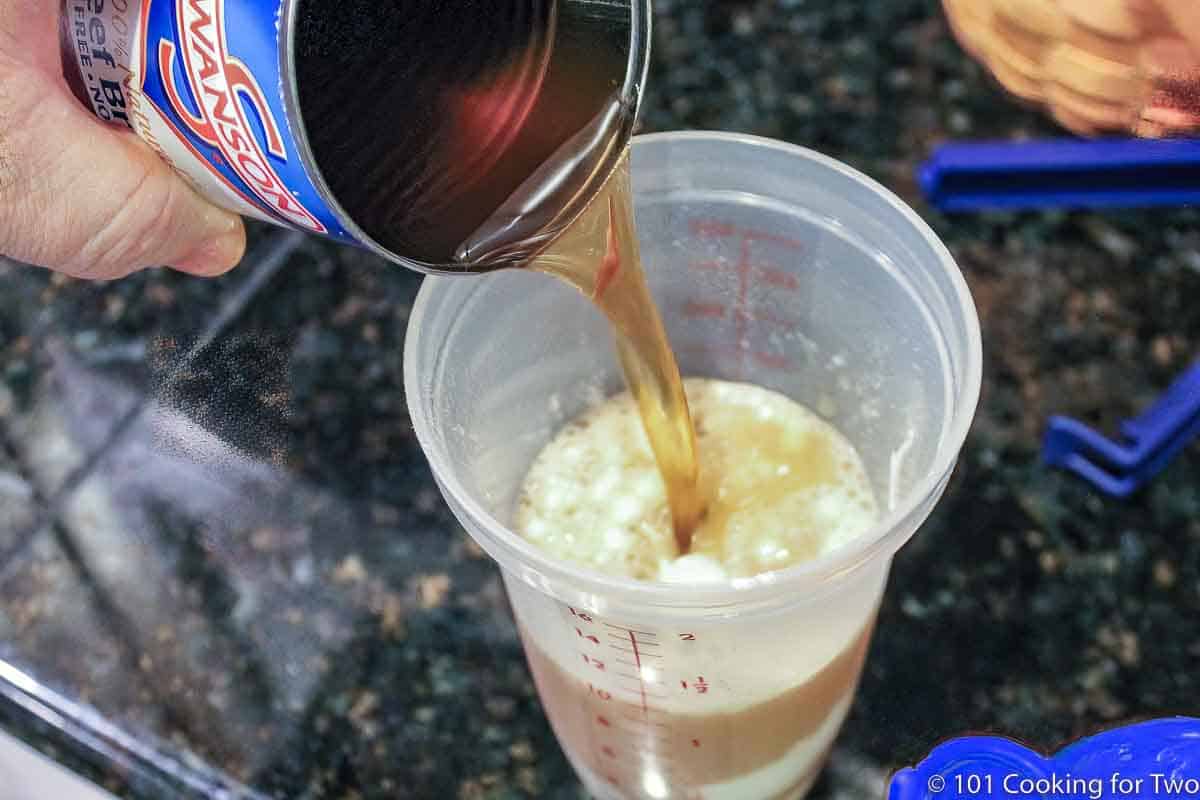
First
Combine about equal amounts of all-purpose flour and cool water or broth in a smaller bowl with a whisk or Tupperware Quick Shaker.
Mix vigorously and continuously. Get it all mixed and smooth. You want about 2 tablespoons of flour per cup of gravy you are making. I generally make about 50% more than I estimate I need, so I can thicken a bit more if needed.
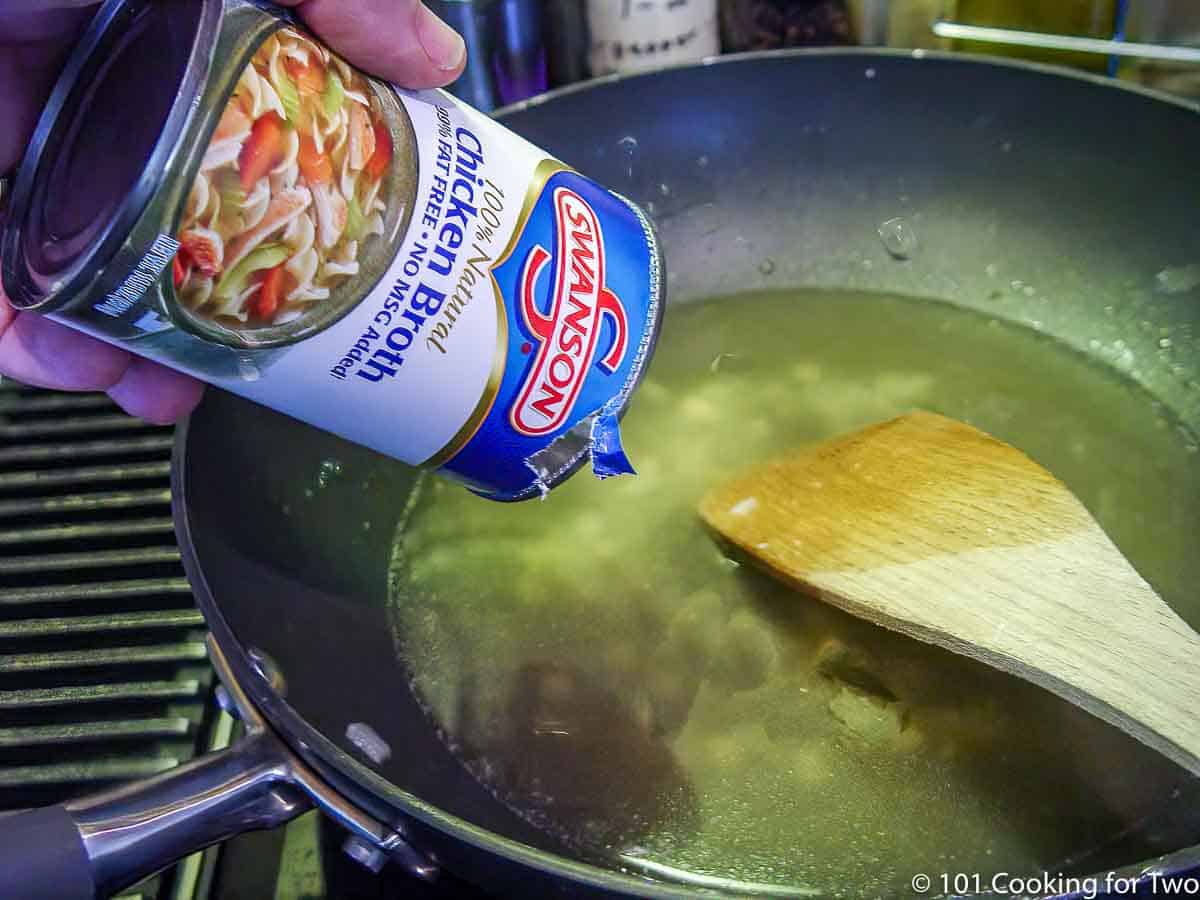
Second
If you have fluid from your meat, use it. It will generally have some fat in the droppings, but you don't need to add any. If you have more than 2 tablespoons of fat per cup of gravy you are making, you should remove some by skimming or using a fat separator. You may remove all the fat if you wish with this method.
You should add broth or other liquid to get to the volume you want to make. You can also add a soup base or bullion for more flavor.
The liquid needs to be in a stovetop-safe pan. Now over medium-high heat, bring the liquid to a boil. Turn on two burners if the pan will cover them.
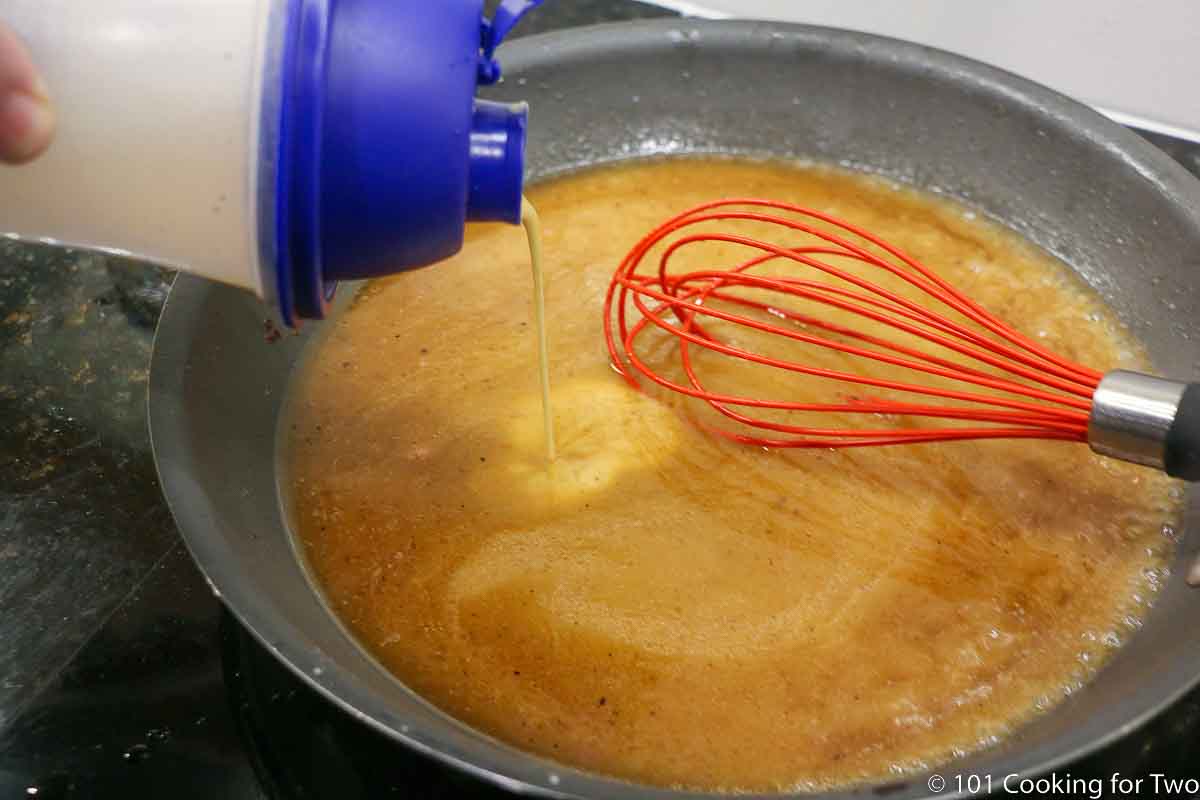
Third
Slowly start pouring the flour mixture to the area of hardest boil SLOWLY while VIGOROUSLY stirring with a slotted spoon or whisk. Turn the heat down to simmer.
Pay attention to the thickness, and stop adding the flour mixture when you get almost the consistency you want. It will thicken a little with the cooking in the next step.
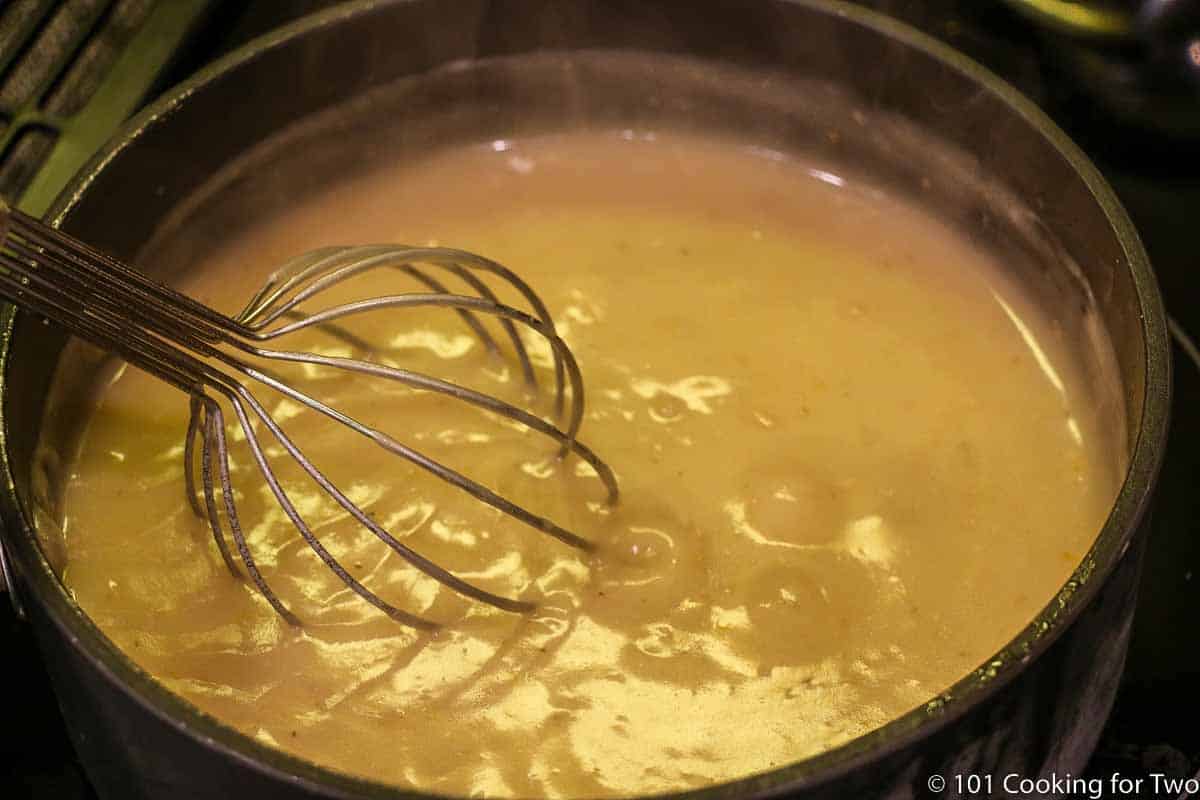
Fourth and Last
Continue to cook for another 2-3 minutes while stirring continuously. Add a bit more flour mixture, if needed, to thicken more or dilute with some broth or water if too thick.
Remove from heat and serve immediately.
NOTES: The Tupperware Quick Shaker is great in this technique. These are about $13 on Amazon, eBay, a Tupperware dealer, or a mall kiosk near you. Google is your friend again.
👨🍳The Roux Method Step-by-Step Photo Instructions
Key ratio: for 1 cup of gravy, you will need 1 cup of broth/drippings, 2 tablespoons fat, and 2 tablespoons of flour. The broth can also be stock or water with bullion or gravy base.
Please read and understand the instructions BEFORE you start. You will not have time to read and do this simultaneously.
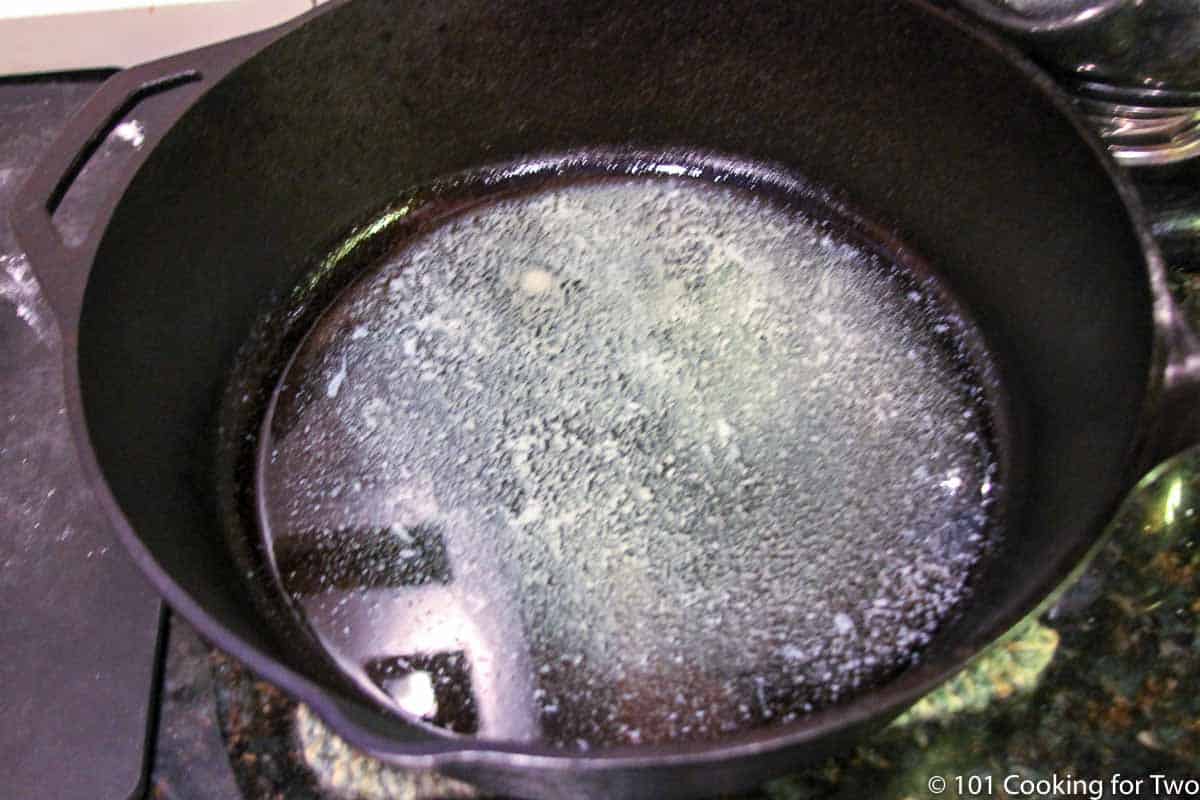
First
Over medium-high heat, heat your fat (butter, drippings from meat, etc.)
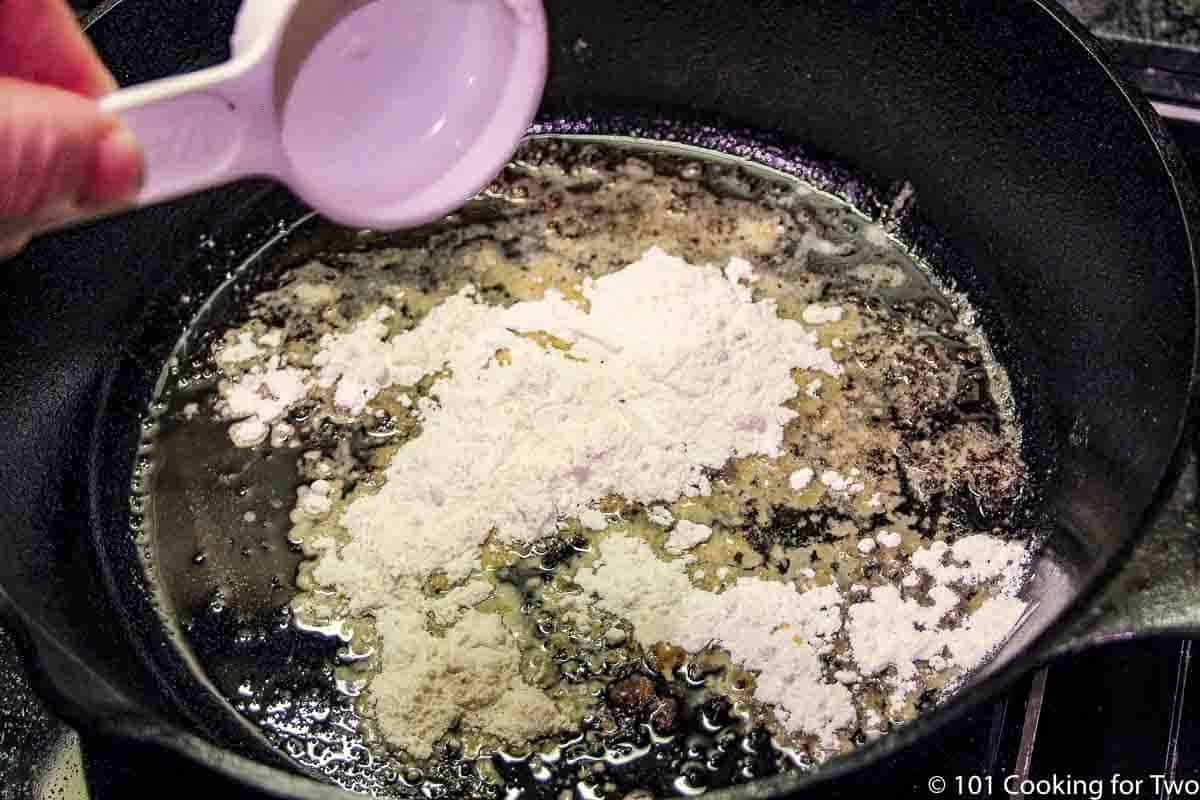
Second
When the fat is hot, turn the heat to medium and sprinkle in an equal amount of flour slowly while stirring or whisking continuously. Cook until the roux is browning some—usually 3-5 minutes.
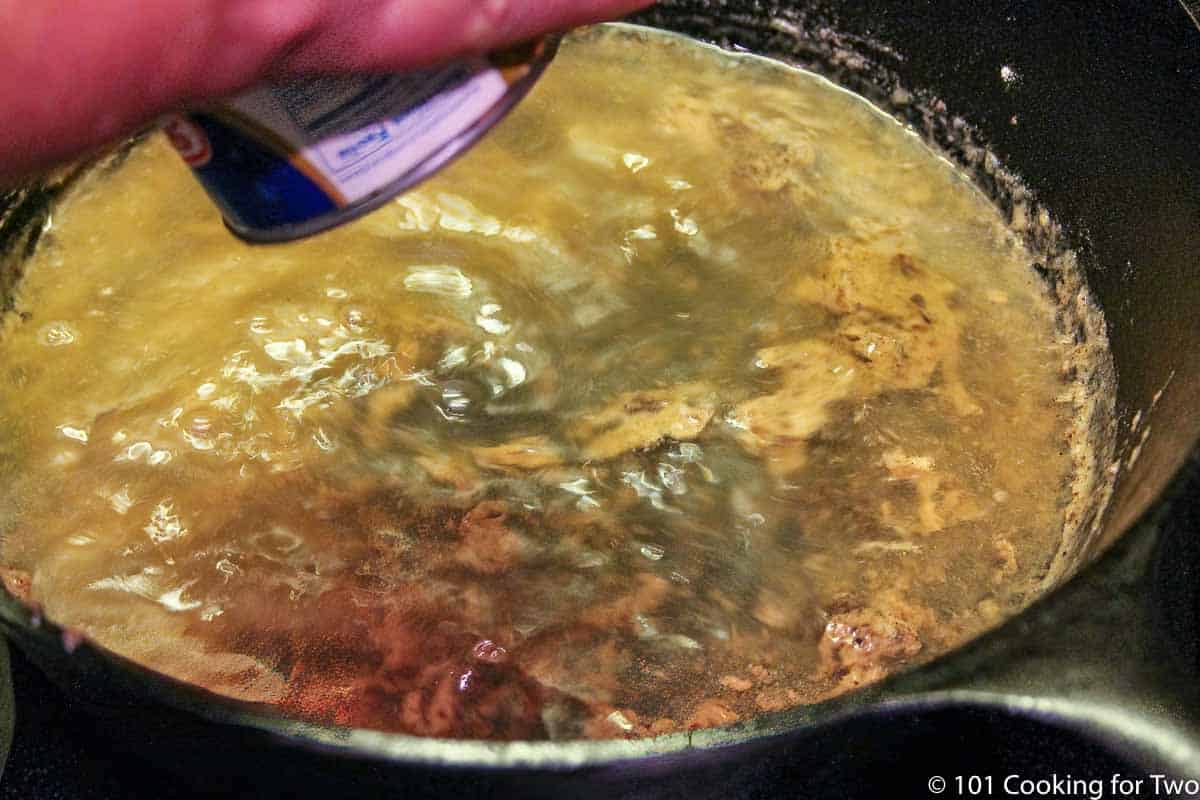
Third
Slowly pour in the liquid for the gravy. Add most of the liquid but not all.
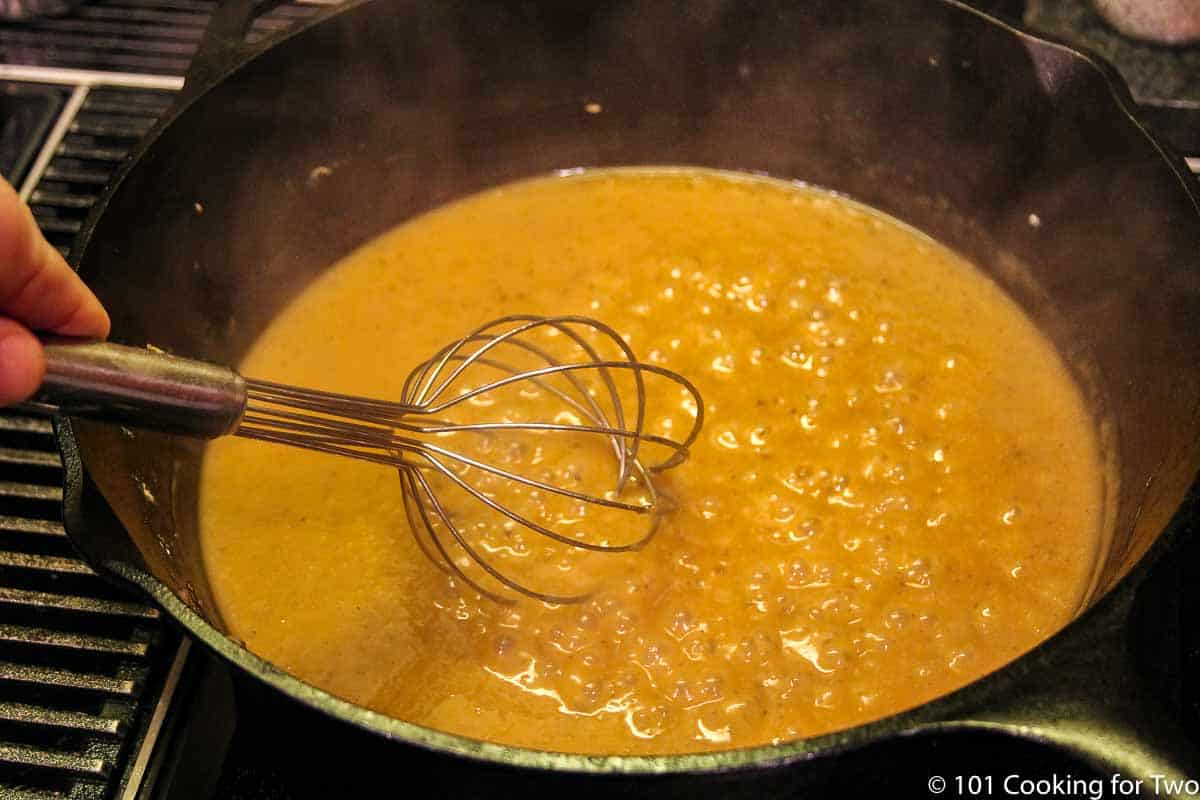
Fourth
Stir continuously to combine and decrease the heat to simmer—cook for a few minutes. Add more liquid if needed. Simmer for a few minutes to cook the flour a bit more.
📖 Recipe
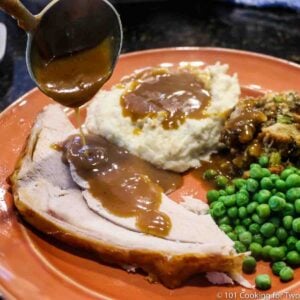
How to Make Gravy—Quick and Easy
Ingredients
- 2 cups Liquid from the cooking
- Extra broth if needed
- 4 tablespoons flour
- salt to taste
Instructions
- PLEASE REVIEW THE PHOTO INSTRUCTIONS BEFORE STARTING - You will not have time to read them while doing this.
The Slurry Method of Making Gravy
- Key ratio: for 1 cup of gravy, you will need 1 cup of broth/drippings and 2 tablespoons of flour.
- Combine about equal amounts of all-purpose flour and cool water or broth in a smaller bowl with a whisk or Tupperware Quick Shaker.Mix vigorously and continuously. Get it all mixed and smooth. You want about 2 tablespoons of flour per cup of gravy you are making. I generally make about 50% more than I estimate I need, so I can thicken a bit more if needed.
- If you have fluid from your meat, use it. It will generally have some fat in the droppings, but you don't need to add any. If you have more than 2 tablespoons of fat per cup of gravy you are making, you should remove some by skimming or using a fat separator. You may remove all the fat if you wish with this method.You should add broth or other liquid to get to the volume you want to make. You can also add a soup base or bullion for more flavor.The liquid needs to be in a stovetop-safe pan. Now over medium-high heat, bring the liquid to a boil. Turn on two burners if the pan will cover them.
- Slowly start pouring the flour mixture to the area of hardest boil SLOWLY while VIGOROUSLY stirring with a slotted spoon or whisk. Turn the heat down to simmer.Pay attention to the thickness, and stop adding the flour mixture when you get almost the consistency you want. It will thicken a little with the cooking in the next step
- Continue to cook for another 2-3 minutes while stirring continuously. Add a bit more flour mixture, if needed, to thicken more or dilute with some broth or water if too thick. Remove from heat and serve immediately.
The Roux Method of Making Gravy
- Key ratio: for 1 cup of gravy, you will need 1 cup of broth, 2 tablespoons of fat, and 2 tablespoons of flour.
- Over medium-high heat, heat your fat (butter, drippings from meat, etc.)
- When the fat is hot, decrease the heat to medium and sprinkle in an equal amount of flour slowly while stirring or whisking continuously. Cook until the roux browning some—usually 3-5 minutes.
- Slowly add the liquid for the gravy. Add most of the liquid but not all.
- Stir continuously to combine and decrease the heat to simmer—cook for a few minutes. Add more liquid if needed. Simmer a few minutes to cook the flour a bit more.
Want to save this recipe for later?
Recipe Notes
Pro Tips:
- General ratio: 2 tablespoons flour:1 cup liquid for both methods. With the roux ratio, also add 2 tablespoons of oil/fat.
- In the slurry method, you add more flour mixture to thicken more if needed.
- In a way, the roux method is the opposite. You add more liquid to thin more.
- If your pan drippings have a lot of fat, you need to skim it or drain it off.
- Have the pan over two burners if the pan is large.
- Gravy can be stored refrigerated for 4-5 days and frozen for 3-4 months.
- Alternative thickeners and other tips are discussed in the post.
- Nutrition is based on a ½ cup serving with the slurry method and chicken broth. No added salt or fat. No drippings since they are unpredictable.
Your Own Private Notes
To adjust the recipe size:
You may adjust the number of servings in this recipe card under servings. This does the math for the ingredients for you. BUT it does NOT adjust the text of the instructions. So you need to do that yourself.
Nutrition Estimate
© 101 Cooking for Two, LLC. All content and photographs are copyright protected by us or our vendors. While we appreciate your sharing our recipes, please realize copying, pasting, or duplicating full recipes to any social media, website, or electronic/printed media is strictly prohibited and a violation of our copyrights.
Originally published February 15, 2011. Updated with expanded options, refreshed photos, and a table of contents to help navigation.


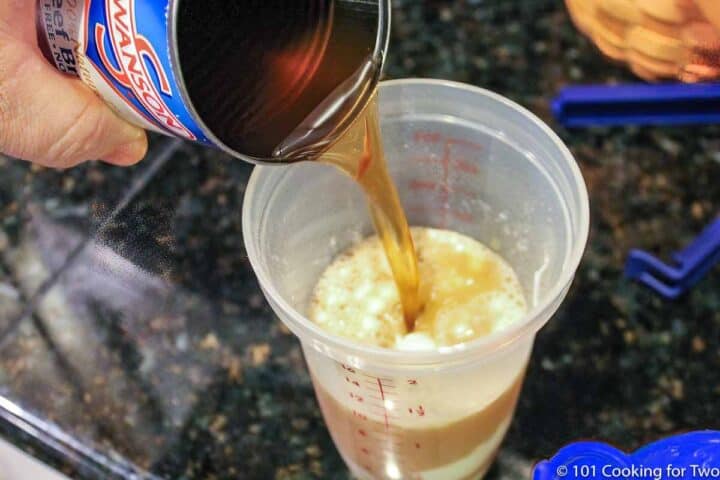
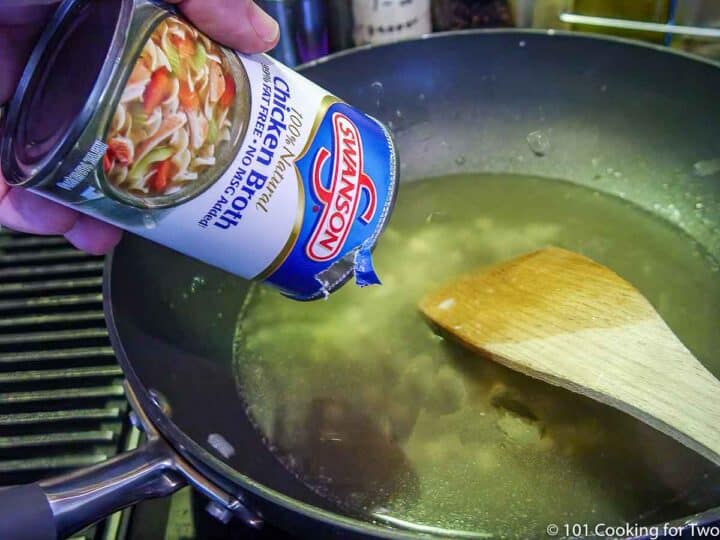
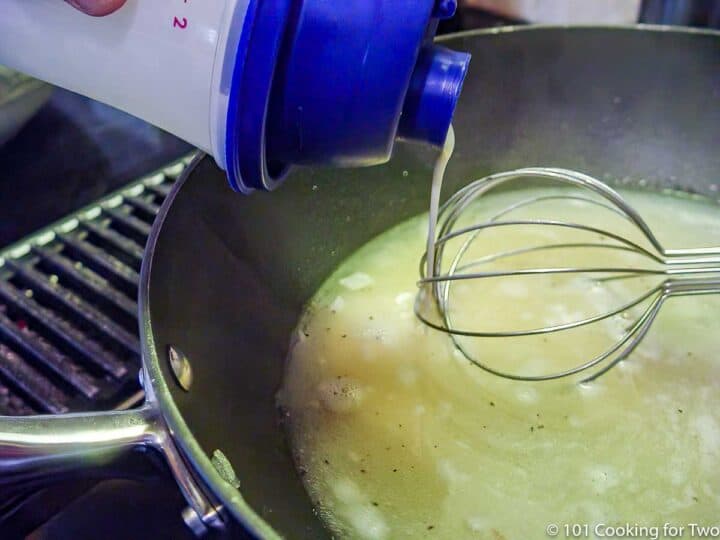
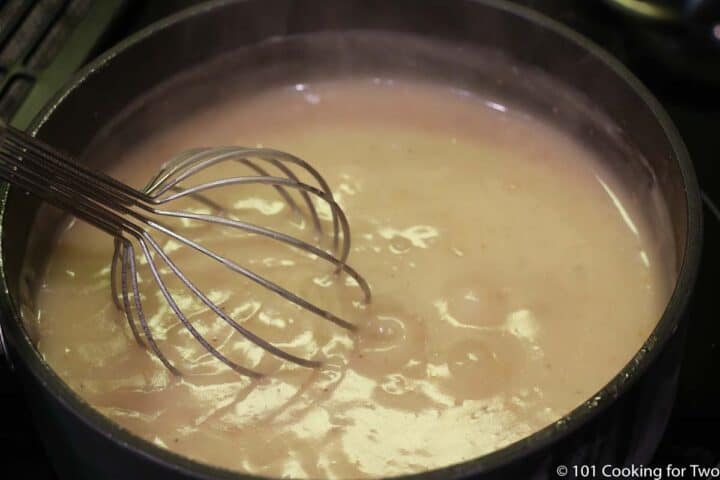
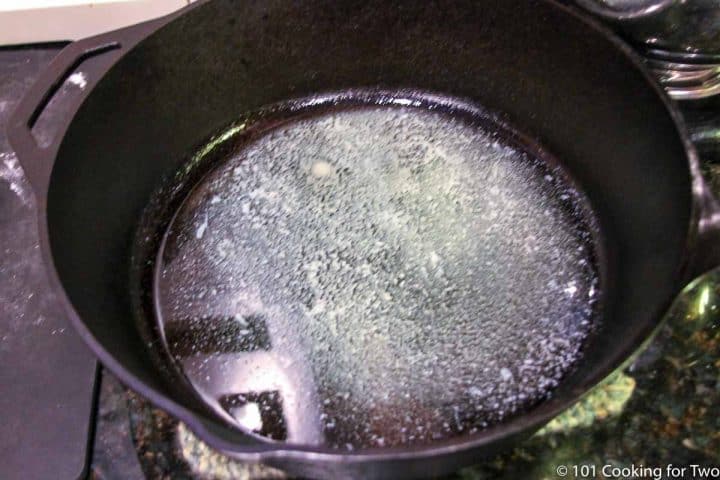
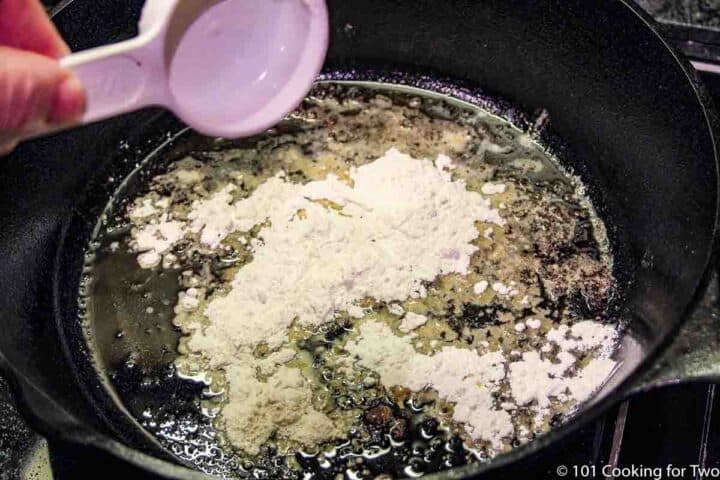
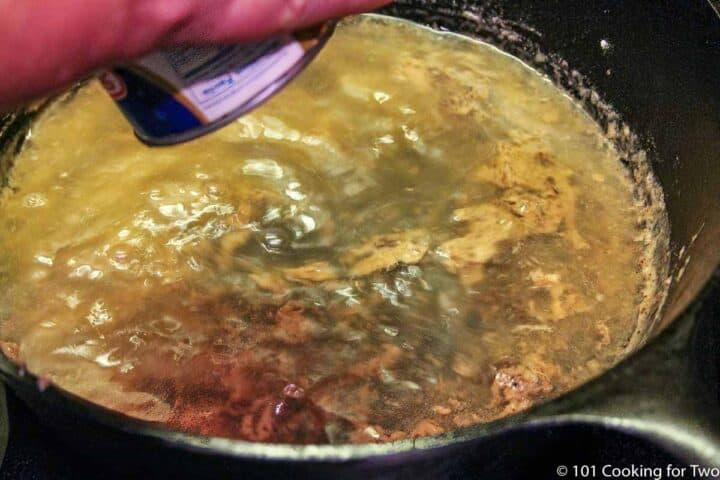
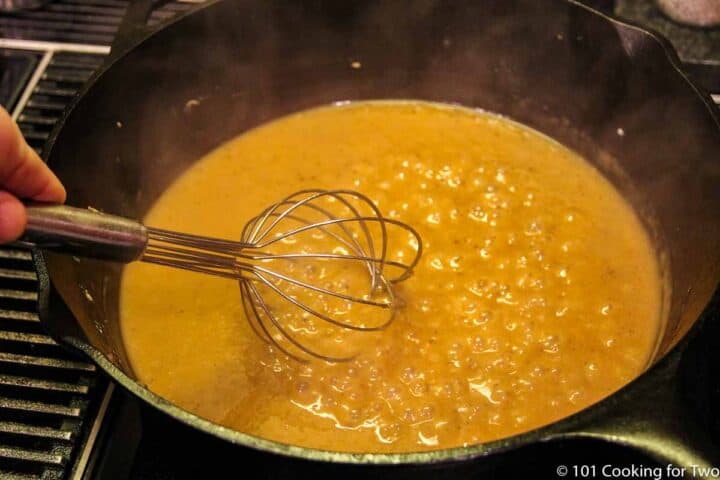
Glenda
Apologies for the following reply as (since I'm incredibly NON tech savvy) I thought it was going to Anna; I realized it before I sent it, but then thought, instead of starting all over, I'd send as is in hopes of getting some really good "old fashioned" recipes like my Gramma used to make. I'll be back soon to see what you've got cooking soon.. Glenda
****************************** Anna~ Unfortunately, I have no idea how to create a blog😔 HOWEVER~ Plz let me know if you do as my grandmother said she had planned to leave her recipes to me in her will (& she had a LOT; in the Era she was born, 99% of married women didn't work outside the home & Grampa LOVED to eat! Lol); tragically, they we're lost in a fire; shortly after dementia had begun & progressed quickly (thankfully, the good Lord saw fit to still let us have her for almost 20 years~ she was less than a month away from being 101 yrs old).. on good days, she tried so hard to remember what she could but there were so many she often got them "mixed together". I sincerely hope to hear about your blog soon & can guarantee I'll visit it often! Good Luck!! Glenda Barrett
Dan Mikesell AKA DrDan
Hi Glenda,
Welcome to the blog. There are occasionally food blogs specializing in vintage recipes but they seem to never last. I don't think Anna followed up on creating a blog—not positive on that... I do have some old recipes, mostly from the 1950s to 1970s range.
I find the best source is your local antique mall. For a dollar or two, you can pick up those old cookbooks your local school PTAs published as fundraisers decades ago. Everybody contributed their own best recipes. About once a year, I go through a couple of malls and come home with treasures. Some from the 1930s but mostly the 1950-1970 range.
Good luck with your quest.
Dan
Anna Gilstrap
I am a 68 year old granny who cooks for a family of four daily plus cooking for many more at holidays. I will definitely use this recipe when I want a brown gravy. My family insists on country gravy (white gravy, usually with sausage in it) and biscuits very often. I have never had anyone complain about them and often receive compliments. Anyway, I don't know how one goes about starting a recipe blog site on the internet but I would love to do that. I want to share old fashioned, economical and/or easy recipes that I think many people would benefit from reading. I love cooking and make simple everyday foods as well as fancy foods. If anyone has any information on how I can start a site to share my recipes and tips I would be very greatful for your help. Thank you, Anna Gilstrap
Dan Mikesell AKA DrDan
Hi Anna,
Welcome to the blog and glad an experienced n cook approves of my discussion.
About start a blog, it is a lot more involved than many want you to believe in the "How to start a blog in 5 minutes" type articles. Following their direction is like a new driver learning to drive by just getting in a car blindfolded and hoping to drive somewhere safely without any guidance. But the car salesman made money which is all they cared about.
I have a long discussion at https://www.101cookingfortwo.com/start-food-blog/ where I cover the basics and lots of the pitfalls. The main issue is other bloggers trying to make money off the newbie blogger want-to-be. They suggest things that make them money and are not the best for you. DON'T FALL FOR IT. The first question for every suggestion, like a spam phone call, what is in it for them. My guide has no paid links, I just got mad about the whole thing and did 4000 words on it.
Let me know if you have any questions. I will drop you an email when I have time probably later today.
Dan
Jeremy Kiter
Very helpful thanks
Anna
Throughout the decades, for as long as I have been making my gravy, I have *never* come across a recipe that mirrors my own nor did I have a name for it - The Slurry Method! My husband of nearly 30 years is a meat/potato/gravy man so when we got married, I joke that learning how to make gravy was in my wedding vows! ; )
By default, I always skip gravy recipe's that are there to compliment the main dish recipe that I'm after (the roux method makes me question my abilities at everything, lol) but that doesn't stop me from scanning over them, always looking for ideas/insights. I'm so glad I've kept that habit and picked up your idea (just in time for Holiday Cooking!) to use cold BROTH instead of water when combining the flour/cornstarch 1:1 to create the liquefied flour/starch mixture. Genius! I started using cornstarch so long ago I don't even recall why except I believe I found the finished gravy to be silkier so I've stuck with it ever since.
Making gravy using the slurry method easily allows for multiplying the ingredients for large events. On several occasions I've made huge batches (gallons +) for church events using a dutch oven. It's also a perfect way to make a gravy when you don't have the fat from a meat or for dietary reasons (that would be me) prefer to forgo the fat and just create a basic gravy. No matter the portion or reason, your slurry method allows the gravy to be tailored to the main dish, so since I don't add the meat fat or pan scrapings for my gravy, instead I add the same seasonings to the gravy mixture that I put in the main dish (a tip I learned years ago in an old cookbook I found in a thrift store - those are the best!), That way there is a compliment of flavors as opposed to a competition or flavorless gravy.
Hope you don't mind that I share, to make a gravy w/o meat fat or pan scrapping, I always start with a warm sauce pan, heat up olive oil and saute' a bit of chopped onion for a few minutes (just enough to sweat them) then add the chosen seasonings and a broken up bay leaf to the onion, stir a few more minutes to get those flavors cracked open, then add my base liquid/broth. Cover and let it simmer on the lowest setting for about 15-20 min. I don't necessarily use 'all' the same seasonings as the main dish but at least the ones which will set the flavor in the right direction. After the simmer, I pour the cooked gravy liquid through a mesh strainer into another saucepan I've had sitting on the stove nearby to get it nice and warm, straining out the cooked onion, bay leaf and seasonings. Now I have just the flavored base for my gravy so I put it on a burner set at med-high and right away start whisking in the measured amount of flour/cornstarch mixture for my batch. I keep whisking and whisking until it starts to come to a boil and begins to thicken; adding more flour/cornstarch mixture (only if necessary) to get that preferred sticks-to-the-back-of-a-spoon thickness. Boom! Perfect gravy, every time - The Slurry Method!
People are so afraid of making gravy but this slurry method you've laid out truly is very easy. I am now known for my gravy and when people come over I'm always asked, "are you making your gravy?" Not kidding! The main tips I always give out: no mater the flavor or dish, never forgo the bay leaf (unless, of course, there is dislike) and most important, when it comes time to make the gravy for the meal, make certain nothing else needs your attention and plant yourself at the stove; make that whisk your best friend because you're not going anywhere! Never stop stirring/whisking for even a second until it's done.
I always notice the following but never comment: When people are over for dinner, I always leave the final steps of whisking to make the finished gravy for last, right before it's time to serve the meal. Fresh, hot-off-the-stove gravy - yum! At the start of the process there's always a 'hush' that comes over the room...an involuntary *Respect* for The Gravy. Lol.
Best Wishes & Happy Holidays to You & Yours!
Anna [aka The Gravy Lady]
Anna
I do want to add about the bay leaf, the longer my broth simmers, the better the flavor since after closer to an hour, the bay leaf can change to deeper complex flavors that are not the star but definitely the shoulders for the rest of the flavors. If I have a long cooking time for the main meal, I start off in my kitchen with the broth simmering up to 30-35 min then leave it sitting on that same but now 'off' burner, nearer to other burners in use or a hot oven always helps, keeping the broth warm and steeping the bay leaf for at least an hour. There is nothing to watch over, it does it all on it's own, much like making a cup of tea but longer steep time. Then after an hour or more, when it's time to make the gravy, I strain out the bay leaf, seasons, and onions and proceed.
Just wanted to clarify since my previous post was a bit vague on this and vagueness doesn't go over well on the internet. When in a hurry or needing to whip up a batch, I'll go with the quicker, shorter simmer time.
DrDan
Hi Anna
I somewhat made up the "slurry method" name but it does fit well. I always talk about using things like cornstarch in a slurry and I needed to call it something. I learned it from my wife but really it is what my mother did but I didn't learn it then. I have never seen it documented in any formal way although I'm sure it is out there without a name.
I do find this method very forgiving so great for home cooking. But it does move fast so the beginners need to read and understand it before starting.
Thanks for the note and experience.
Happy Holidays
Dan